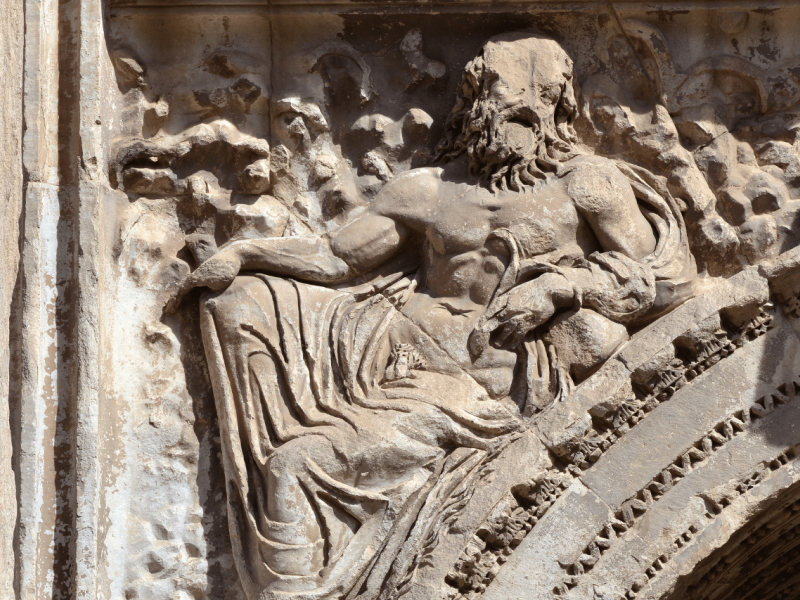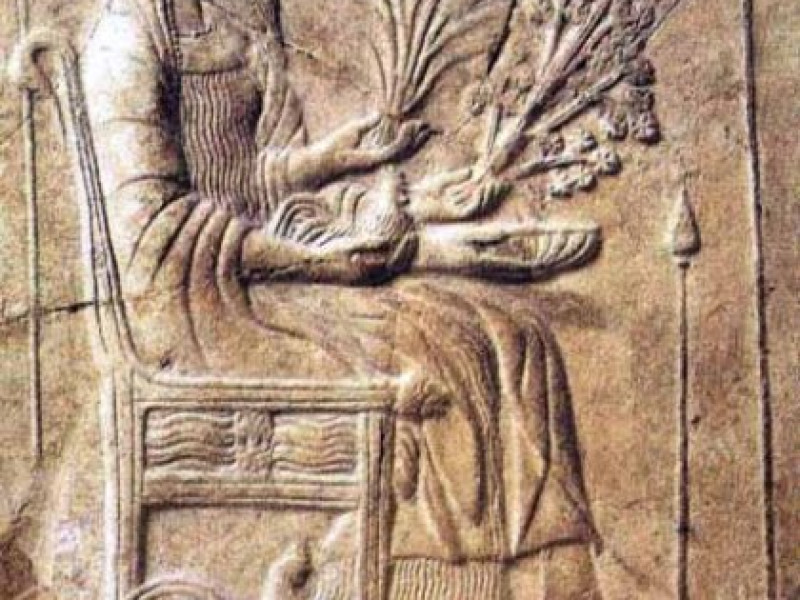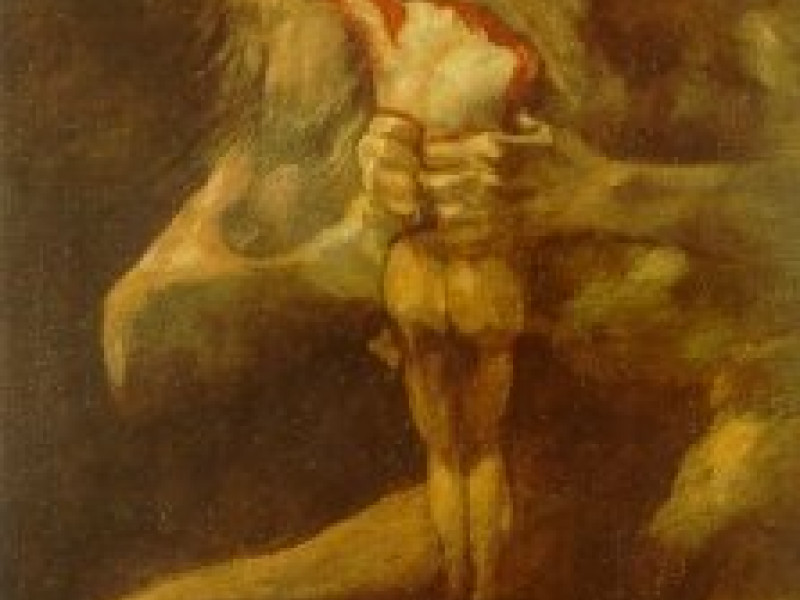Hades (Pluto)
Lord of the Underworld. Hades was the son of the titans, Cronus and Rhea. Hades was the god of the dead, and ruled his world with more absolute power and authority than Zeus. Hades was a grim god, not an evil one.
His other name Aïdoneus (Aidoneus) means the "Unseen One". To the Romans, he was known as Pluto (wealth) and Dis Pater or Dis. Pluto is the name of the ninth planet in the solar system. Charon is Pluto's moon or satellite.
Hades was among the children of Cronus to be swallowed by their father, and later disgorged. Hades was armed with the Cap of Darkness (invisibility), which he used to aid Zeus in the war against the Titans.

Persephone and Hades in the Underworld
Marble relief, 480-450 BC
Museo Nazionale, Reggio Calabria (Italy)
After aiding brothers Zeus and Poseidon in overthrowing Cronus and sending the other Titans to Tartarus, he received the world of the dead, known as Underworld, as his domain.
Hades rarely left the Underworld. He drove his chariot drawn by black horses and abducted Persephone, daughter of Zeus and his sister, Demeter. He wanted Persephone as his wife and queen of the Underworld. He was forced to compromise with his sister, Demeter: he allowed Persephone to live two-thirds of the year on earth with her mother and a third with him in the Underworld.
In the war between Heracles and the people of Pylus, for some reason Hades left his realm and took the side of Neleus and the Pylians, so he received a wound from the hero.
The Underworld was a place where the souls of humans found their resting places. In the deepest region called Tartarus, it was a place of punishment for mortals who committed the worse sins or crimes. Tartarus also served as a prison for the Titans and other gods. The Underworld was guarded by a three-headed hound named Cerberus. Cerberus kept the living and the dead apart. Cerberus only allowed a few of the living to pass through the gate of Hades: Heracles, Theseus, Orpheus, Aeneas and Psyche.
Heracles, for his last labour, freed Theseus and dragged Cerberus to the surface (see the Twelfth Labour of Heracles). Theseus was there because he was aiding his rash friend Peirithoüs who wanted to abduct Hades' wife, Persephone, and marry her. Knowing of their plan, Hades trapped them in the Chairs of Forgetfulness. Heracles failed to free Peirithoüs. (See also Theseus.)
During the war between Heracles and Neleus, king of Pylos, Hades came to the surface, taking the side of the Pylians, and Heracles wounded him with an arrow. Hades returned to his domain, suffering from his wound.
Hades and Persephone were charmed by the music and song of Orpheus, who had lost his wife Eurydice. Hades allowed Orpheus to bring his wife back to life on the strict condition that Orpheus didn't look at his wife until they reached the light on the surface. Orpheus looked back at his wife too soon, and her shade returned to the abode of the dead. Hades refused Orpheus entrance a second time. (See Orpheus and Eurydice.)
Psyche, wife of Cupid (Eros), was on an errand for her mother-in-law Venus (Aphrodite). She was told to fetch the make-up box from Persephone.
According to Ovid and the geographer Strabo, Hades took the nymph Menthe or Minthe as his mistress. Persephone jealously trampled the unfortunate girl, transforming her into a plant known as mint.
Hades and Persephone weren't the only ones to live in the Underworld. There were Thanatos (Death), the winged-brother Hypnos (Sleep), and Morpheus (Dream), who was the son of Hypnos. Styx was the river goddess of one of the Underworld rivers, and the goddess Hecate also dwelled in this domain.
Hades had cattle which he kept near the cattle of Geryon, near Erytheia. Hades' herdsman was named Menoetes. When Heracles (10th labour) arrived and stole Geryon's cattle, Menoetes went directly to the three-headed king with the news of the stolen cattle. Menoetes met Heracles again in the 12th labour where he wrestled the hero, and would have been crushed to death had not Persephone intervened.
Elis was the only city that built a temple to Hades in one of its precincts. The Eleans were the only ones to worship him. The construction was built after Heracles' war against Neleus in Pylos. Only once a year, the doors to the temple of Hades would open, but no one would enter the temple except the priests.
For more details about the Underworld, Tartarus and Elysian Fields, go to Underworld.
Related Information
Name
Hades, Aïoneus, Ἅιδης – "Unseen One" or "Invisible One" (Greek).
Pluto, Πλούτων – "Rich One" (Greek).
Pluto ("wealth"), Dis, Dis Pater, Orcus (Roman).
Sources
Homeric Hymns.
The Iliad was written by Homer.
Theogony was written by Hesiod.
Library was written by Apollodorus.
Metamorphoses was written by Ovid.
Fabulae was written by Hyginus.
Related Articles
See also Pluto.
Cronus, Rhea, Persephone, Styx, Charon.
Creation, Underworld.
See also Demeter and Persephone in the Mother Goddesses.
Facts and Figures: Astronomy.
By Jimmy Joe







